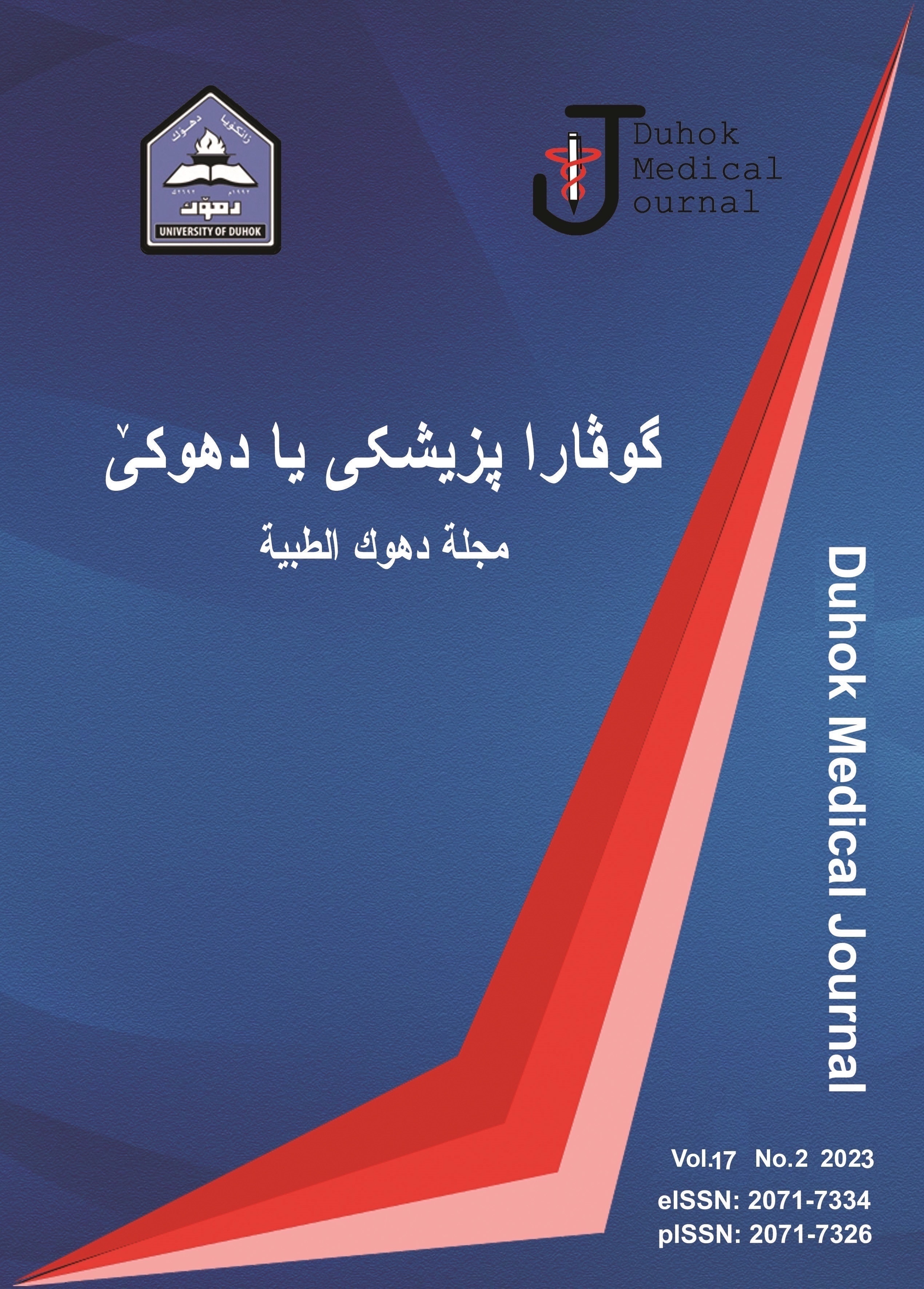ANTI-MÜLLERIAN HORMONE LEVEL AS A PREDICTIVE FACTOR IN THE DIAGNOSIS OF POLYCYSTIC OVARIAN SYNDROME IN DUHOK PROVINCE – KURDISTAN REGION, IRAQ
Abstract
https://doi.org/10.31386/dmj.2023.17.2.5
Background: Polycystic ovary syndrome is one of the most common endocrine conditions upsetting fertile-aged ladies and is considered to be one of the most common causes of infertility. The study aimed at evaluating serum anti-müllerian hormone levels among patients with polycystic ovarian syndrome.
Methods: All enrolled women were subjected to clinical examination, ultrasound examination, and anti-müllerian hormone level measurement. Eighty-seven women diagnosed with clinical signs of polycystic ovary syndrome as well as 87 controls were enrolled.
Results: The current study revealed significant variation among both patients and control groups regarding parity, irregularities in menstrual cycles, ovarian sizes, and features of hyperandrogenism (abnormal hair growth; Acne). No significant difference was seen regarding age and body mass index. Using the Receiver operating characteristic curve, a serum value of anti-müllerian hormone > 3.2 ng/ml was considered specific (91.5%) and sensitive (80.5%) for diagnosis of polycystic ovary syndrome with a P value of < 0.001.
Conclusion: Polycystic ovary syndrome can be accurately diagnosed with AMH level, being significantly associated with increased ovarian size, lower parity rate, and higher incidence of menstrual cycle disturbances.
Downloads
References
2. Rotterdam ESHRE/ASRM‐Sponsored PCOS consensus workshop group. Revised 2003 consensus on diagnostic criteria and long‐term health risks related to polycystic ovary syndrome (PCOS). Hum Reprod 2004; 19(1): 41–7.
3. Sharma A, Welt CK. Practical approach to hyperandrogenism in women. Med Clin North Am. 2021;105(6):1099-1116. doi: 10.1016/j.mcna.2021.06.008.
4. Ahmed N, Batarfi A, Bajouh O, Bakhashab S. Serum anti-Müllerian hormone in the diagnosis of Polycystic Ovary Syndrome in association with clinical symptoms. Diagnostics (Basel). 2019 Oct 1;9(4):136. doi: 10.3390/diagnostics 9040136.
5. Gruijters MJ, Visser JA, Durlinger AL, Themmen AP. Anti-Müllerian hormone and its role in ovarian function. Molecular and Cellular Endocrinology, (2003).;211(1):85-90. doi: 10.1016/J.MCE.2003.09.024.
6. Rudnicka E, Kunicki M, Calik-Ksepka A, Suchta K, Duszewska A, Smolarczyk K, Smolarczyk R. Anti-Müllerian Hormone in Pathogenesis, Diagnostic and Treatment of PCOS. Int J Mol Sci. 2021 Nov 19;22(22):12507. doi: 10.3390/ijms222212507.
7. Fanchin R, Schonauer LM, Righini C, Guibourdenche J, Frydman R, Taieb J. Serum anti-Mullerian hormone is more strongly related to ovarian follicular status than serum inhibin B, estradiol, FSH and LH on day 3. Hum Reprod (Oxford, England) 2003;18(2):323–7. doi: 10.1093/humrep/deg042
8. Goodarzi MO, Dumesic DA, Chazenbalk G, Azziz R. Polycystic ovary syndrome: etiology, pathogenesis and diagnosis. Nat Rev Endocrinol. 2011;7(4):219-31. doi: 10.1038/nrendo.2010.217.
9. Johansson J, Stener-Victorin E. Polycystic ovary syndrome: effect and mechanisms of acupuncture for ovulation induction. Evidence-based Complementary and Alternative Medicine 2013(1): 762615. DOI: 10.1155/ 2013/762615
10. Lujan ME, Jarrett BY, Brooks ED, Reines JK, Peppin AK, Muhn N, Haider E, Pierson RA, Chizen DR. Updated ultrasound criteria for polycystic ovary syndrome: reliable thresholds for elevated follicle population and ovarian volume. Hum Reprod. 2013; 28(5): 1361-8. doi: 10.1093/ humrep/ det062.
11. Kotlyar AM, Seifer DB. Ethnicity/ Race and Age-Specific Variations of Serum AMH in Women-A Review. Front Endocrinol (Lausanne). 2021 Feb 9; 11: 593216. doi: 10.3389/ fendo.2020.593216. PMID: 33633682; PMCID: PMC7900163.
12. Garg D, Tal R. The role of AMH in the pathophysiology of polycystic ovarian syndrome. Reprod Biomed Online. 2016 Jul; 33(1): 15-28. doi: 10.1016/ j.rbmo.2016.04.007.
13. Du X, Ding T, Zhang H, Zhang C, Ma W, Zhong Y, Qu W, Zheng J, Liu Y, Li Z, Huang K, Deng S, Ma L, Yang J, Jiang J, Yang S, Huang J, Wu M, Fang L, Lu Y, Luo A, Wang S. Age-Specific Normal Reference Range for Serum Anti-Müllerian Hormone in Healthy Chinese Han Women: A nationwide Population-Based Study. Reprod Sci. 2016;23(8):1019-27. doi: 10.1177/ 1933719115625843.
14. Wells J, Treleaven Ph, Cole T. BMI compared with 3-dimensional body shape: The UK national sizing survey . American Journal of Clinical Nutrition 2007; 85(2): 419-25. DOI: 10.1093/ajcn/85.2.419.






